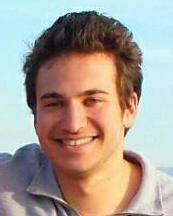Celebration of Scholars
Enhanced Carbon Dioxide Study to Observe Avoidance Behaviors and Anxiety Vulnerability
 Name:
Theresa Regetz
Name:
Theresa Regetz
Major: Neuroscience
Hometown: Lyndhurst, NJ
Faculty Sponsor: Daniel Miller
Other Sponsors: Martino, Paul; Miller, Justin
Type of research: Independent research
 Name:
Leonard Ferdman
Name:
Leonard Ferdman
Major: Biology
Hometown: Los Angeles, California
Faculty Sponsor: Paul Martino
Other Sponsors: Martino, Paul; Miller, Justin
Type of research: Independent research
 Name:
Paul Martino
Name:
Paul Martino
Department: Natural Science
Type of research: Independent research
 Name:
Justin Miller
Name:
Justin Miller
Department: Natural Science
Type of research: Independent research
 Name:
Daniel Miller
Name:
Daniel Miller
Department: Natural Science
Type of research: Independent research
 Name:
Emma Patschorke
Name:
Emma Patschorke
Major: Neuroscience
Hometown: Ballwin, Missouri
Faculty Sponsor: Paul Martino
Other Sponsors: Martino, Paul; Miller, Justin
Type of research: Independent research
 Name:
Joscelyn Stefanek
Name:
Joscelyn Stefanek
Major: Neuroscience
Hometown: Green Bay, Wisconsin
Faculty Sponsor: Paul Martino
Other Sponsors: Martino, Paul; Miller, Justin
Type of research: Independent research
Abstract
Enhanced Carbon Dioxide Study to Observe Avoidance Behaviors and Anxiety Vulnerability
Theresa Regetz, Leonard Ferdman, Emma Patschorke, Joscelyn Stefanek, Justin Miller, Ph.D., Daniel Miller, Ph.D., and Paul F. Martino, M.S., Ph.D.
Abstract
Background: Those with high behavioral inhibition (BI) learn faster and take longer to stop responding to the stimulus after it ends using operant conditioning (Sheynin, 2014; Servatius, 2008). Humans with high BI are more vulnerable to develop the pathological disorder Post Traumatic Stress Disorder (PTSD) upon exposure to an unusually stressful situation. One defining feature of PTSD is an avoidance behavior that persists despite the cessation of the stressful event. Using 3% carbon dioxide as a mild stress stimulant, avoidance behavior as measured by an avoidance task can show differences in those with BI compared to those without it. CO2 provokes a stress response by decreasing the pH of the blood, hence causing exhalations to increase to reduce the amount of dissolved carbon dioxide, increasing breathing rate overall. The stress response provoked by the increase in blood acidity is likely to produce a hormonal response by increasing saliva cortisol levels.
Methods: Cortisol will be measured via saliva samples prior to and following the task to determine cortisol levels. CO2 will be mixed in a Tissot Spirometer to a 3% mixture and delivered via a mask through a closed tubing system.
Goal: By using carbon dioxide as a mild stressor, the avoidance behavior in participants can be measured to determine the relationship between avoidance behaviors under stress for those with high and low BI.
Submit date: March 12, 2015, 5:14 p.m.
